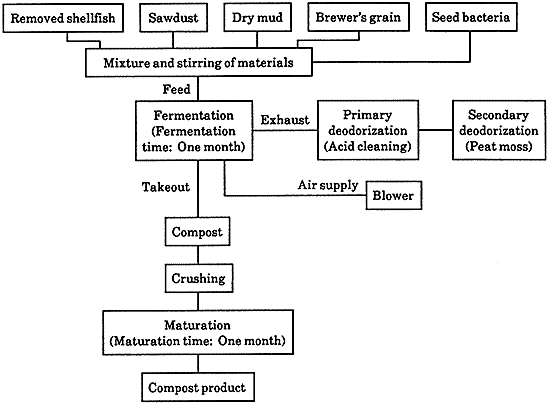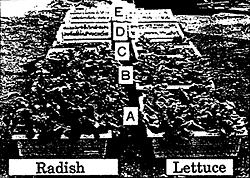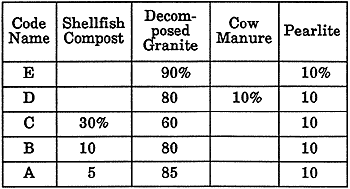Waste Treatment Technology in JAPAN
Compost
Fig. 1 Steps in Manufacture of Removed-shellfish Compost
The compost was tested to investigate its effectiveness in fertilizing the soil and improving the growth of lettuce and radish. Fig. 2 shows the test result.
Fig. 2 Fertilizer Test Result (31 days after sowing)
1. Overview
Sessile shellfish, such as mussels, adhere to the walls of condenser cooling seawater conduits at thermal and nuclear power plants. Large amounts of shellfish are removed at regular intervals. Attempts have been made to produce compost from the removed shellfish, using fermentation tanks of the stationary box type.

2. Production Process
In order to stabilize fermentation and adjust moisture content, shellfish are mixed with sawdust, dry mud, brewer's grain, and seed bacteria. The addition of charcoal and used drip grind moderates the unpleasant odor during fermentation.
Normally, in order to prevent such fermentation odors, exhaust is treated with sulfuric acid at the primary deodorization step; and furthermore, peat-moss is used on the treated exhaust at the secondary deodorization step. Fig. 1 shows steps in the manufacture of compost.

Fertilizer Test (31 days after sowing)


3. Research Result
- The fertilizer test results revealed that shellfish compost has greater
fertilizing effect than cow manure.
- Because shellfish growing in sea water are used as a raw material, the product
contains trace elements essential for plants.
- Organic matter contained in the product activates microorganisms in soil, thus
improving the fertility of soil.
4. Problems and Future Solutions
In order to sophisticate this technology, it is necessary to ensure the following items:
- Even on a non-experimental basis, the system can produce compost, and verifies
comparable ability with the prototype.
- The test crushing step crushed the shells into small pieces. Improvement,
however, will enable the step to crush the shells into powder.
- The presence of salt in the fermented product, apparently, does little or no
harm to the growth of vegetation.
- Some heavy metals may be contained in sea water and mud. It is possible,
however, to remove such items from the fermented product.
11-20 Nakoji 3-chome, Amagasaki, Hyogo 661-0974, Japan
Telephone: (06)491-0221
Facsimile: (06)498-7662